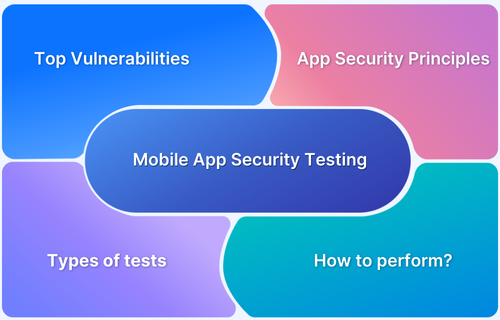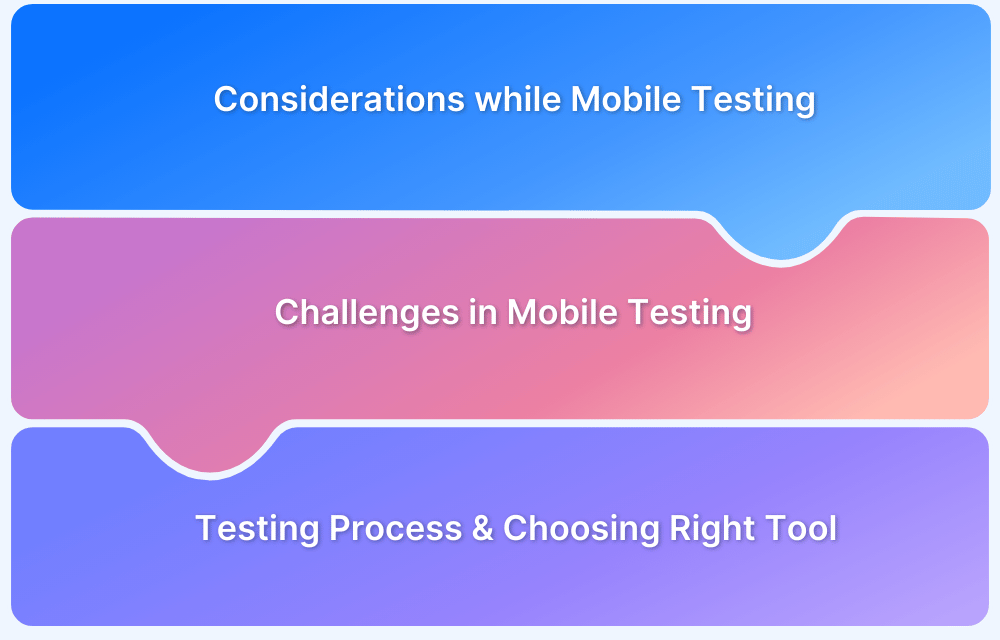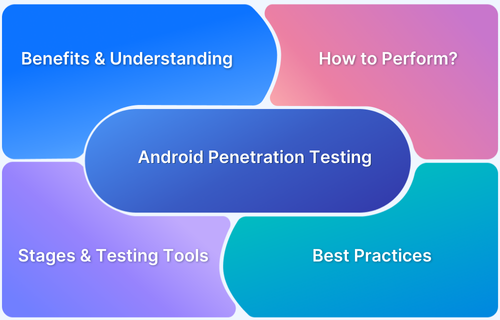Given the sensitive data that mobile apps handle, from personal information to financial details, security testing is essential to prevent unauthorized access and data breaches. Mobile app security testing helps identify vulnerabilities and weaknesses within an app that attackers could exploit.
This includes detecting issues like insecure data storage, inadequate encryption, and improper authentication, which can lead to data breaches, unauthorized access, or malicious attacks. A thorough mobile app security testing requires a structured approach that includes all assessments, including vulnerability scanning and penetration testing.
This guide provides a comprehensive overview of mobile app security testing, including its importance, key vulnerabilities, testing methodologies, and best practices.
What is Mobile App Security Testing?
Mobile application security testing is the process of assessing a mobile application’s security posture to identify vulnerabilities that may expose user data, functionality, or the overall integrity of the application. It involves simulating real-world attacks to test how resilient the app is against different threats.
Why is Mobile App Security Testing Important?
The importance of the security testing for mobile apps cannot be exaggerated. 75% of applications contain at least one security flaw, while 60% of data breaches were due to unpatched vulnerabilities.
Data breaches and leaks often lead to significant financial damages, reputation loss, or even legal repercussions.
Below are the key reasons why mobile app security testing is important.
- Protects user data: Ensures sensitive user information, such as personal and financial data, is secure from breaches
- Prevents unauthorized access: Identifies vulnerabilities that could allow attackers to gain unauthorized access to app features or user accounts
- Maintains app integrity: Protects the app’s functionality from being compromised by malicious activities
- Ensures compliance: Helps meet legal and regulatory requirements for data protection and privacy, such as GDPR or HIPAA
- Mitigates financial losses: Reduces the risk of financial damage caused by data breaches, legal liabilities, and loss of reputation
- Protects brand reputation: Prevents security incidents that could damage the company’s reputation and consumer confidence
Examples of Mobile App Security Breaches
Here are some examples of companies that have faced security breaches recently.
- Hackers steal Zagg customers’ credit cards in third-party breach
- Flipaclip data breach exposes 895,000 user records, including minors
- MoneyGram hit by major hack that exposed customer Social Security numbers and bank accounts
Understanding Mobile App Security Issues: Android vs iOS
Android and iOS apps are developed and distributed through different ecosystems, which influences their security vulnerabilities. The open-source nature of Android and the closed environment of iOS contribute to varying risks on each platform.
Android Mobile App Security Issues
Android’s open-source nature and diverse range of devices and manufacturers introduce various security risks. The platform’s flexibility can sometimes result in inconsistent security measures, and the availability of third-party app stores increases the likelihood of encountering malicious apps.
Common security issues in Android include:
- MITM (Man-in-the-Middle) Attacks: Attackers intercept and manipulate communication between the app and the server to steal data
- Cryptojacking: Malicious code uses device resources for cryptocurrency mining without user consent
- Malvertising: Malicious ads deliver harmful code or exploit vulnerabilities when interacted with
- Phishing and Social Engineering: Attackers deceive users into disclosing personal information through fake prompts or messages
- Component-related threats: Vulnerabilities in app components or libraries can be exploited to gain unauthorized access
- Permissions-based vulnerabilities: Apps may request excessive permissions, leading to potential misuse of sensitive data
- Rooting: Modified devices (rooted) bypass security measures, allowing apps to access sensitive system data
iOS Mobile App Security Issues
Though iOS is considered more secure due to its closed ecosystem, it still faces security challenges, particularly in data storage and sensitive information management.
Here are common iOS app security issues.
- Data Leakage: Improper handling or storing of sensitive data can lead to accidental exposure
- Storing data locally on the device: Sensitive data stored locally can be easily accessed if the device is compromised
- Jailbreaking: A jailbroken device bypasses iOS’s built-in security features, making it more susceptible to attacks
- Phishing and Social Engineering: Like Android, iOS apps can be targets of phishing attacks designed to steal user data
- Allowing 301 Redirects: Malicious redirects can lead users to fake websites and compromise sensitive information
- Stolen certificates: Attackers use stolen certificates to impersonate trusted apps or services
Read More: Android vs iOS Mobile App Testing
Top Mobile Application Vulnerabilities
To perform security testing, it is essential to understand the types of vulnerabilities. The following are some of the most common vulnerabilities found in mobile apps.
1. Malware Attacks
Malicious software can come through compromised applications to steal user data or completely control a device. This occurs when sessions are not invalidated after logout or session tokens are predictable, thus allowing attackers to take over active sessions.
2. Unauthorized Access
Weak authentication mechanisms or access control weaknesses might result in losing sensitive data to unauthorized users. The vulnerability could arise from failure to set up the default setting, potentially exposing sensitive data and functionalities to unauthorized users.
3. Weak Authentication
Weak authentication vulnerabilities arise based on the failure of an application to authentically handle user credentials, allowing unauthorized access to user accounts. Poor password policies, lack of MFA, and easily guessed credentials make apps vulnerable to brute-force attacks.
4. Data Leakage
Poor encryption, incorrect handling of data, and insecure data storage make confidential information vulnerable to potential exposure. Through this, attackers may gain unauthorized access to sensitive information, such as login passwords, tokens for authentication, or personal information.
Poorly stored data allows malicious applications and individuals easy access to information in a way that compromises the security and privacy of users.
5. Insecure Communication
Without proper encryption, data transmitted between a mobile app and its server can be intercepted by attackers. This makes apps vulnerable to man-in-the-middle attacks, where hackers eavesdrop, alter, or steal sensitive information.
Thus, use secure communication protocols like TLS/SSL to protect user data and prevent unauthorized access during transmission.
6. Code Tampering
Attackers exploit code vulnerabilities to inject malicious code or alter app functionality. This can lead to cross-site scripting (XSS) or SQL injection attacks, compromising data and system security.
7. Weak Encryption Algorithms
Weak encryption allows attackers to decrypt sensitive data, exposing it during storage or transmission. Apps that rely on outdated or insufficient encryption methods are vulnerable to interception and data breaches. Implement strong encryption protocols, such as AES-256, to protect sensitive information from unauthorized access and attacks.
Principles of Secure Mobile App Development
Secure mobile app development requires a holistic approach, incorporating security considerations throughout the entire software development lifecycle (SDLC). Key principles include:
- Secure Coding Practices: Developers should use secure coding practices to avoid common security vulnerabilities. This includes validating all inputs, sanitizing user data, and using parameterized queries to prevent injection attacks.
- Data Encryption: This refers to converting sensitive data into an unreadable format to prevent unauthorized access, even if the device or server is compromised. This includes data at rest, stored on the device or server, and in transit, as it is transmitted over a network.
- Authentication and Authorization: Strong authentication and authorization help control access to mobile apps and their resources. Authorization should always be handled on the server side to prevent users from altering permissions on the client side.
- Regular Updates: Updates are crucial for addressing security vulnerabilities and enhancing an app’s security posture. Developers should plan regular updates to ensure continuous protection, especially when critical vulnerabilities are discovered post-deployment.
- Third-Party Library Management: Most mobile applications rely on third-party libraries for functionality. Even properly managed libraries could still be insecure. Thus, conduct a thorough risk assessment before integrating any third-party libraries.
Types of Mobile App Security Tests
It is essential to perform various types of security tests for a comprehensive mobile app security assessment.
1. Vulnerability Scanning
Vulnerability scanning with automated scanning tools checks for known security weaknesses in mobile applications through systematic checks. The scans compare the app’s code, configurations, and dependencies with a database of known vulnerabilities (for example, the Common Vulnerabilities and Exposures database, or CVE).
These scans identify potential problems such as insecure coding practices, outdated libraries, and weak authentication mechanisms. While effective at detecting common vulnerabilities, vulnerability scans can generate a high number of false positives and often miss the more sophisticated or novel attacks.
2. Penetration Testing
Ethical hackers mimic real-world attacks to determine where vulnerabilities exist and exploit them. This method provides more actionable results than vulnerability scanning.
Penetration testing simulates real-world cyberattacks to identify vulnerabilities. It goes beyond automated scans by evaluating the entire application, including backend systems and APIs, for weaknesses like poor security settings or unencrypted data.
Pen tests provide a thorough assessment of the app’s security measures and are crucial for organizations, especially in highly regulated industries, to comply with internal and external security standards.
Read More: Guide to Android Penetration Testing
3. Risk Assessment
A risk assessment goes beyond simply identifying vulnerabilities; it evaluates the likelihood and potential impact of exploiting those vulnerabilities. This involves considering factors such as the sensitivity of the data handled by the app, the potential consequences of a breach, and the attacker’s capabilities.
A risk assessment helps prioritize which vulnerabilities to address first, focusing resources on the most critical threats. It often involves a combination of automated scans, manual code review, and expert analysis to provide a comprehensive understanding of the app’s security posture.
4. Security Posture Assessment
A security posture assessment evaluates an app’s overall security. It combines results from vulnerability scans, risk assessments, and an analysis of the app’s security controls, development practices, and regulatory compliance. This assessment identifies areas for improvement and measures the effectiveness of security practices.
It offers a high-level overview of the app’s security, guiding decisions on security investments and resource allocation. The assessment typically includes recommendations to strengthen security controls and address identified risks.
Mobile App Security Testing Techniques
There are different types of application security testing techniques.
1. Static Analysis
Static Application Security Testing (SAST) is a proactive approach that analyzes a mobile application’s source code, bytecode, or binaries without executing the code. Static testing focuses on identifying vulnerabilities such as insecure API calls, hardcoded secrets, and unsafe data handling patterns at an early stage of development.
SAST tools provide real-time feedback to developers, enabling them to address security issues as they code, which can significantly reduce the time and effort required for subsequent testing. By examining the application’s structure and logic, SAST helps prevent vulnerabilities from being exploited in live environments.
2. Dynamic Analysis
Dynamic Application Security Testing (DAST) occurs during runtime, mimicking external attacks to identify vulnerabilities that may arise when the application is in use. Dynamic testing assesses how the app behaves under various conditions and can reveal issues such as improper authentication, session management flaws, and other vulnerabilities that are only apparent when the app is active.
This testing is essential for evaluating the application’s response to real-world attack scenarios and for ensuring compliance with security standards before the app’s release.
3. Interactive Analysis
Interactive Application Security Testing (IAST) combines elements of both SAST and DAST by utilizing instrumentation embedded in the app’s code. IAST tools monitor the application’s behavior and interactions during runtime, providing comprehensive insights into potential vulnerabilities while also analyzing the source code.
This method allows for a deeper understanding of the app’s security posture, as it evaluates both static code elements and dynamic execution patterns. IAST is typically performed during the testing or QA phase of the software development lifecycle (SDLC) and can help identify complex vulnerabilities that may not be detectable through traditional testing methods.
4. Manual Penetration Testing
Manual penetration testing is a cybersecurity assessment in which security experts, often called ethical hackers or pen testers, manually simulate real-world attacks against a system or network. Unlike automated scans, manual testing relies on the pentester’s expertise and intuition to identify vulnerabilities.
This hands-on approach allows for a deeper understanding of the system’s weaknesses, including complex vulnerabilities that automated tools might miss, such as those involving social engineering or exploiting subtle logic flaws.
While more time-consuming and expensive than automated testing, manual penetration testing provides a more comprehensive and reliable assessment, particularly for critical systems where a thorough understanding of potential attack vectors is crucial.
5. Fuzz Testing
Fuzz testing, also known as fuzzing, is an automated software testing technique that involves feeding a program invalid, unexpected, or random data as input. The goal is to identify vulnerabilities and crashes by observing the program’s response to this malformed data.
This can reveal security flaws like buffer overflows, memory leaks, denial-of-service vulnerabilities, and functional bugs that might not be uncovered through traditional testing methods. Fuzzing is particularly useful for testing software that handles user input, network protocols, or file formats. It’s a powerful tool for improving software security and stability.
Mobile Application Security Testing Checklist
A comprehensive checklist for mobile app security testing should include:
1. Secure the Source Code
Protecting your mobile application’s source code is paramount. This involves using version control systems like Git with robust access controls to limit code access to authorized developers only. Regular backups are essential. Implementing secure coding practices, such as those outlined by OWASP, helps prevent vulnerabilities from being introduced into the codebase.
Regular code reviews and the use of Static Application Security Testing (SAST) tools can further enhance security by automatically identifying potential vulnerabilities. Finally, digitally signing your app ensures its authenticity and prevents tampering.
2. Implement Multi-Factor Authentication (MFA)
Multi-factor authentication (MFA) significantly strengthens user authentication by requiring more than one verification factor. This could involve a combination of something the user knows (password), something the user has (phone), and something the user is (biometrics).
Implementing MFA makes it exponentially harder for attackers to gain unauthorized access, even if they obtain a password. Common MFA methods include time-based one-time passwords (TOTP), push notifications, and biometric authentication.
3. Employ Encryption for Communications
Encrypting all communication channels between your mobile app and the server is crucial for protecting sensitive data in transit. This involves using HTTPS for all communication and employing strong encryption algorithms like AES-256 to scramble data, making it unreadable to unauthorized parties.
Data encryption should also be implemented for data at rest (stored on the device) using secure storage mechanisms provided by the mobile operating system (e.g., Keychain on iOS, KeyStore on Android).
4. Enable Runtime App Self-Protection (RASP)
Runtime Application Self-Protection (RASP) adds a layer of security by monitoring the application’s behavior while it’s running. RASP solutions can detect and respond to malicious activities in real time, such as attempts to tamper with the app or access sensitive data. This proactive approach helps mitigate threats that might evade other security measures.
5. Adopt an API Security Framework
Your mobile app likely relies on APIs to communicate with backend services. A robust API security framework is essential to protect these communication channels. This includes implementing secure authentication and authorization mechanisms (e.g., OAuth 2.0, JWT), input validation to prevent injection attacks, and rate limiting to prevent denial-of-service attacks. Regularly updating and patching APIs is also crucial.
6. Implement Code Obfuscation Techniques
Code obfuscation makes it significantly harder for attackers to reverse-engineer your app’s code. This involves transforming the code into a more complex and difficult-to-understand form while maintaining its functionality.
Obfuscation techniques can include renaming variables and functions, inserting dummy code, and control flow obfuscation. While not foolproof, it adds a significant barrier to attackers attempting to understand and exploit your app’s logic.
Read More: Best Practices for Mobile App Testing
How to Perform Mobile App Security Testing?
Performing mobile app security testing involves a multi-step process.
1. Planning and Requirements Analysis
The first step to performing mobile app security testing is to define your requirements.
- Define Security Objectives and Scope: Identify critical assets, set security goals (e.g., protecting data, transaction integrity), and determine the testing scope (backend servers, APIs, etc.)
- Understand the App Architecture: Analyze platform specifics (iOS, Android), create data flow diagrams, and list third-party components
- Compliance Requirements: Identify applicable regulations (e.g., GDPR, HIPAA) and follow guidelines like OWASP MASTG
2. Setting Up the Testing Environment
A well-configured test environment is essential for accurate results. Here’s how to set up your testing environment.
- Testing Devices: Use real devices to test how your application works across different hardware and software configurations
- Network Settings: Configure proxy tools (e.g., Burp Suite, OWASP ZAP) and simulate various network conditions
- Access to Source Code: Obtain the code for static analysis and ensure legal compliance
3. Conducting Static Analysis (SAST)
This phase focuses on identifying vulnerabilities before the app is deployed.
- Automated Scanning: Use tools like BrowserStack Code Quality to scan for vulnerabilities and misconfigurations
- Manual Code Review: Focus on critical sections (authentication, encryption) and check for hard-coded secrets
- Identify Common Vulnerabilities: Look for injection flaws and insecure data storage
Read More: Static testing – Tools and Techniques
4. Performing Dynamic Analysis (DAST)
Dynamic analysis evaluates the app’s behavior in real-time. Here’s how.
- Runtime Testing: Test the app’s behavior under normal and abnormal conditions, focusing on input validation
- Network Communication Analysis: Intercept network traffic to check data security and verify SSL/TLS protocols
- Session Management Testing: Test session security (hijacking attempts, token expiration)
5. Executing Penetration Testing
This phase simulates real-world attacks to uncover vulnerabilities.
- Simulated Attacks: Conduct black box and grey box testing to uncover vulnerabilities
- Exploit Vulnerabilities: Use tools like Metasploit and attempt privilege escalation
- Platform-Specific Testing: Test Android (e.g., intents, exported components) and iOS (e.g., keychain, .plist files) for unique vulnerabilities
How can an Advanced Testing Platform like BrowserStack Help?
BrowserStack is a real device cloud testing platform. It gives you access to 3500+ devices, browsers, and OS configurations to test your app’s security. This allows you to test your app’s security across different environments and ensure it works seamlessly on various devices.
Key features of BrowserStack App Automate include
- Real-device testing: Test your app’s security features on real devices hosted in the cloud
- Automated test execution: Run automated tests on both iOS and Android devices at scale
- Integration with CI/CD pipelines: Integrate BrowserStack into your CI/CD pipeline to run tests after each deployment
- Biometric authentication: Validate biometric authentication and passcodes to prevent unauthorized access
- Latest devices: BrowserStack supports the latest devices, including the S25 family. This ensures your app is tested against the most up-to-date configurations
Conclusion
Mobile app security testing ensures vulnerabilities are identified and addressed before they compromise user data or app integrity. Regular testing, secure coding practices, and timely updates are essential to prevent data breaches, enhance user trust, and comply with regulations.
Tools like BrowserStack, with real-device testing environments, help verify app security under real-world conditions. With BrowserStack App Automate, you can run hundreds of parallel tests across multiple devices and browsers to ensure comprehensive security testing.





